Have you ever wondered why you feel more awake and alert when you look at your phone or computer screen late at night? The answer lies in the blue light emitted by these devices, which has been shown to have a significant impact on our circadian rhythm.
Our circadian rhythm is the natural 24-hour cycle that regulates our sleep-wake cycle, hunger, and other bodily functions. It is regulated by a part of the brain called the hypothalamus, which responds to external cues such as light and darkness. When we are exposed to blue light, our brain is tricked into thinking that it is daytime, and our circadian rhythm is disrupted.
Key Takeaways:
- Blue light emitted by electronic devices can disrupt our circadian rhythm.
- Circadian rhythm is important for regulating our sleep-wake cycle and other bodily functions.
- Exposure to blue light can trick our brain into thinking it is daytime, leading to disrupted sleep patterns.
Understanding Circadian Rhythm
Circadian rhythm is the natural biological process that regulates our sleep-wake cycle, dictating when we feel alert and when we feel sleepy. This cycle influences our daily routines, from our eating habits to our physical performance. A disruption in this rhythm can have negative consequences on our health and wellbeing, including circadian rhythm sleep disorders (CRSDs).
Our bodies detect changes in light and darkness through specialized cells in the retina of our eyes. When these cells detect light, they send a signal to the suprachiasmatic nucleus (SCN) located in the hypothalamus of the brain. The SCN then signals the release of hormones such as cortisol, which peaks in the morning to increase alertness, and melatonin, which is released in the evening to promote relaxation and sleep.
External factors such as exposure to blue light can disrupt this delicate balance, impacting our ability to fall asleep and stay asleep. Research has found that exposure to blue light in the evening can suppress the release of melatonin, leading to reduced sleep quality and subsequent daytime fatigue and decreased performance.
Circadian Rhythm Disruption
Disruptions to our circadian rhythm can manifest in a variety of ways, including CRSDs and seasonal affective disorder (SAD). CRSDs can take many forms, including delayed sleep phase disorder (DSPD) and non-24-hour sleep-wake disorder (N24SWD). DSPD is characterized by a delayed sleep-wake cycle, making it difficult to wake up in the morning and fall asleep at night. N24SWD occurs when an individual’s circadian rhythm is longer than 24 hours, resulting in difficulty maintaining a consistent sleep-wake schedule.
SAD, on the other hand, is a type of depression that is related to changes in season and is caused by a disruption to the body’s internal clock. It is often treated through a combination of medication, light therapy, and lifestyle adjustments.
In the next section, we will explore the impact of blue light on the circadian rhythm and how it can lead to disruptions in our sleep-wake cycle.
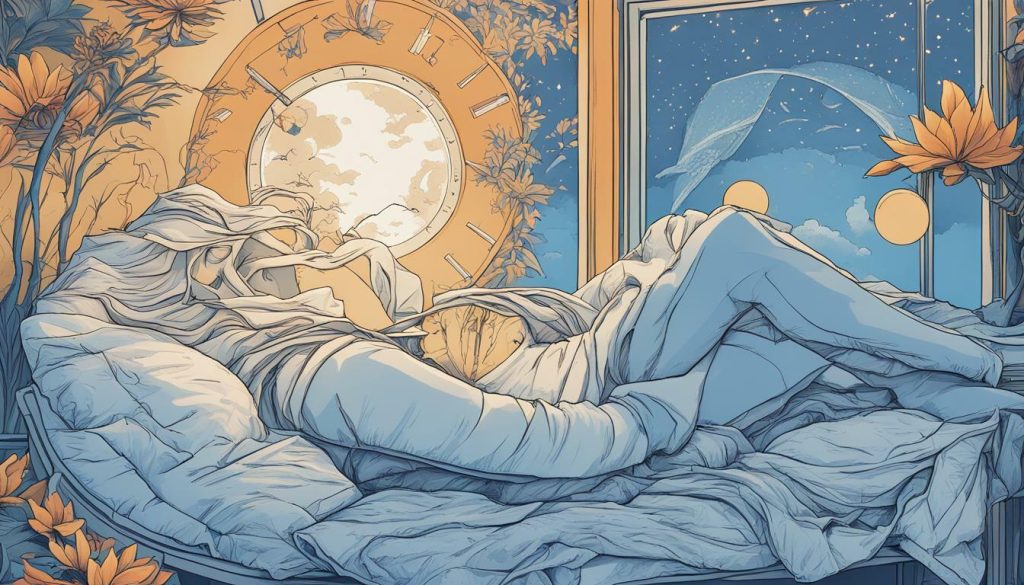
The Science Behind Blue Light
Blue light is a type of visible light that has a short wavelength and high energy. It is found in sunlight, as well as in artificial light sources such as LED lights, computer screens, and smartphones. While exposure to blue light during the day can help regulate our circadian rhythm and boost alertness, excessive exposure to blue light in the evening can have negative effects on our sleep quality.
Melatonin, a hormone produced by the brain’s pineal gland, plays a crucial role in regulating our sleep-wake cycle. It is released in response to darkness and helps us feel drowsy and fall asleep. However, exposure to blue light in the evening can suppress the production of melatonin, making it harder to fall asleep and resulting in reduced sleep quality.
Studies have also shown that exposure to blue light during the night can disrupt the body’s natural melatonin production, leading to circadian rhythm disruption and sleep disorders such as insomnia. This is particularly problematic for individuals who work night shifts or spend a lot of time using electronic devices before bed.
To promote healthy sleep habits, it is recommended to limit exposure to blue light in the evening. This can be achieved through the use of blue light filters or glasses, as well as by reducing screen time before bed. Creating a sleep-friendly environment that minimizes exposure to blue light can also be beneficial for overall sleep quality.

Impact on Sleep Patterns
Blue light exposure can have a significant impact on sleep patterns, contributing to sleep disorders such as insomnia and restless sleep. This is due to the disruption of the body’s natural circadian rhythm, which regulates the sleep-wake cycle.
Research has shown that exposure to blue light before bedtime can suppress the production of melatonin, the hormone that promotes sleep. This can make it harder to fall asleep and result in poor sleep quality, leaving you feeling fatigued and irritable during the day.
Additionally, exposure to blue light during the night can further disrupt the circadian rhythm, causing a range of negative effects on sleep quality and overall health. Shift workers, who are often exposed to blue light at odd hours, are particularly vulnerable to circadian rhythm disruption, leading to a higher risk of sleep disorders.
To maintain a healthy circadian rhythm and improve sleep quality, it is crucial to regulate blue light exposure and promote a sleep-friendly environment. This can include reducing screen time before bed, using blue light filters on devices, and investing in sleep-promoting products such as blue light blocking glasses.

Blue Light Sources and Exposure
Blue light is prevalent in our daily lives, and it is essential to understand where it comes from and how it can impact our sleep. Electronic devices such as smartphones, tablets, and laptops emit blue light, as do artificial light sources like LED and fluorescent bulbs. Exposure to blue light from these sources can disrupt our sleep-wake cycle and prevent us from getting the rest we need.
The duration and timing of blue light exposure are crucial factors that affect sleep quality. Prolonged exposure to blue light in the evening can suppress the production of melatonin, making it harder to fall asleep and stay asleep throughout the night. This disruption can lead to insomnia, sleep fragmentation, and other sleep disorders that can impact our health and daily life.
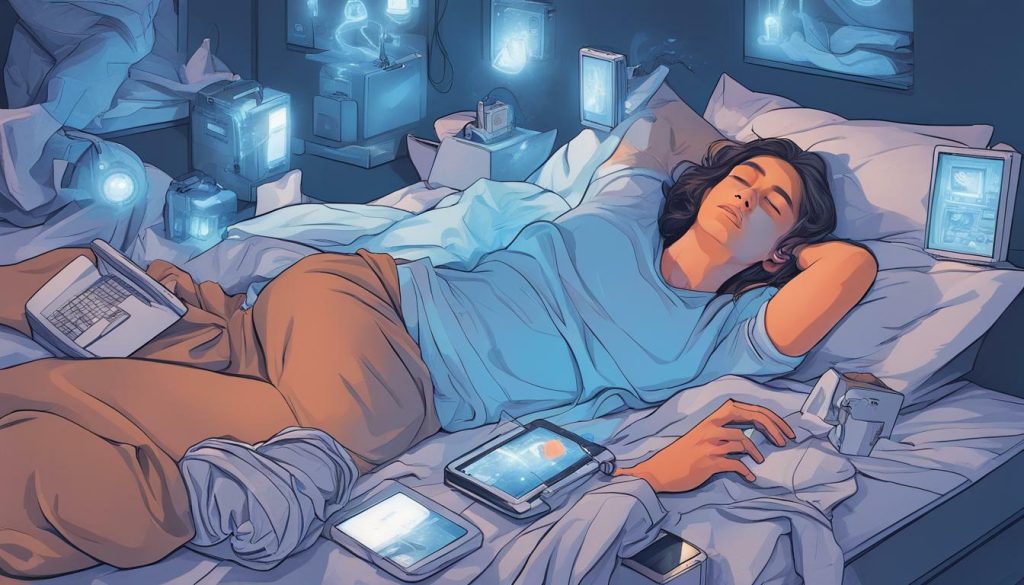
Therefore, it is important to manage our exposure to blue light, especially in the hours leading up to bedtime. One effective strategy is to limit screen time before bed, avoiding the use of electronic devices for at least 30 minutes before sleep. Some devices have built-in blue light filters that reduce the amount of blue light emitted, which can also help improve sleep quality.
Another option is to wear blue light-blocking glasses that filter out blue light, especially for those who work night shifts or tend to use electronic devices in the evening. Room lighting can also be adjusted to minimize blue light exposure, such as dimming the lights or using warm-colored bulbs. In summary, managing exposure to blue light can significantly improve our sleep quality and help us maintain a healthy circadian rhythm.
Blue Light and Sleep Quality
Excessive exposure to blue light can have a negative impact on sleep quality, resulting in fragmented sleep and reduced deep sleep. Studies suggest that the effects of blue light on sleep quality may be even more significant for individuals who are already experiencing sleep disorders.
One study found that exposure to blue light in the evening led to delayed sleep onset, decreased REM sleep, and increased wakefulness throughout the night. Another study found that individuals who used electronic devices before bed experienced reduced sleep quality and increased sleepiness during the day.
The effects of blue light on sleep quality are thought to be due to its impact on the production of melatonin, a hormone that regulates sleep and wakefulness. Blue light exposure in the evening can suppress the release of melatonin, making it harder to fall asleep and stay asleep throughout the night.
To promote optimal sleep quality, it is recommended to limit blue light exposure in the evening and create a sleep-friendly environment in the bedroom. This can be achieved by using warm-colored bulbs, dimming lights, and minimizing screen time before bed.
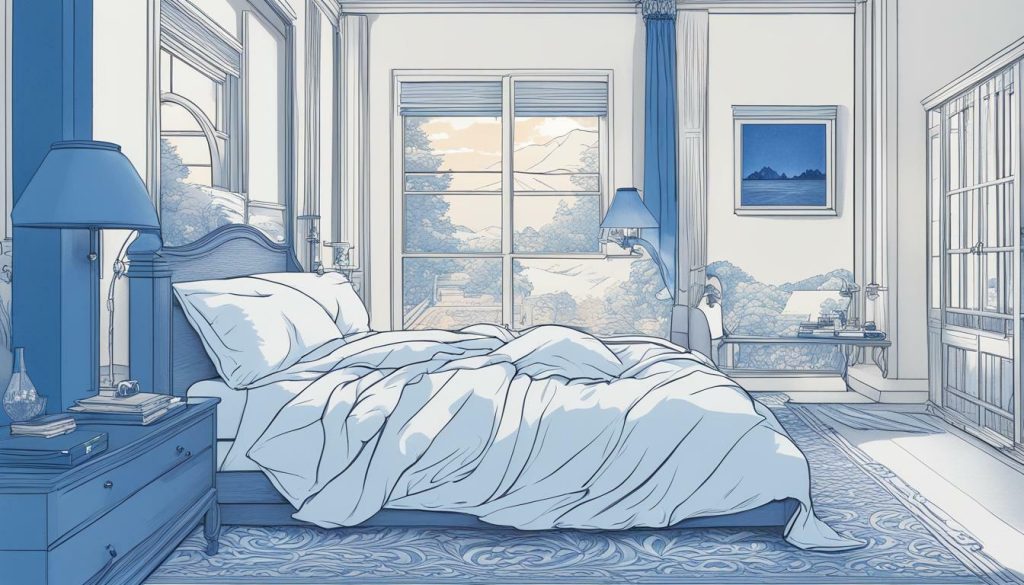
Blue Light and Melatonin Production
Blue light exposure can have a significant impact on the production of melatonin, a hormone that regulates sleep and wakefulness. Studies have shown that blue light suppresses melatonin production, making it harder to fall asleep and stay asleep.
One study found that individuals who were exposed to blue light before bed experienced a 50% reduction in melatonin production compared to those who were not exposed to blue light. Another study found that using electronic devices such as smartphones and tablets before bed significantly reduced the amount of melatonin produced.
This disruption in melatonin production can have serious consequences for sleep quality and overall health. Chronic melatonin suppression has been linked to a higher risk of developing sleep disorders, mood disorders, and even certain types of cancer.
It’s important to be mindful of blue light exposure in the evening and take steps to manage it. This can include limiting screen time before bed, using blue light filters or glasses, and reducing overall exposure to artificial light sources.
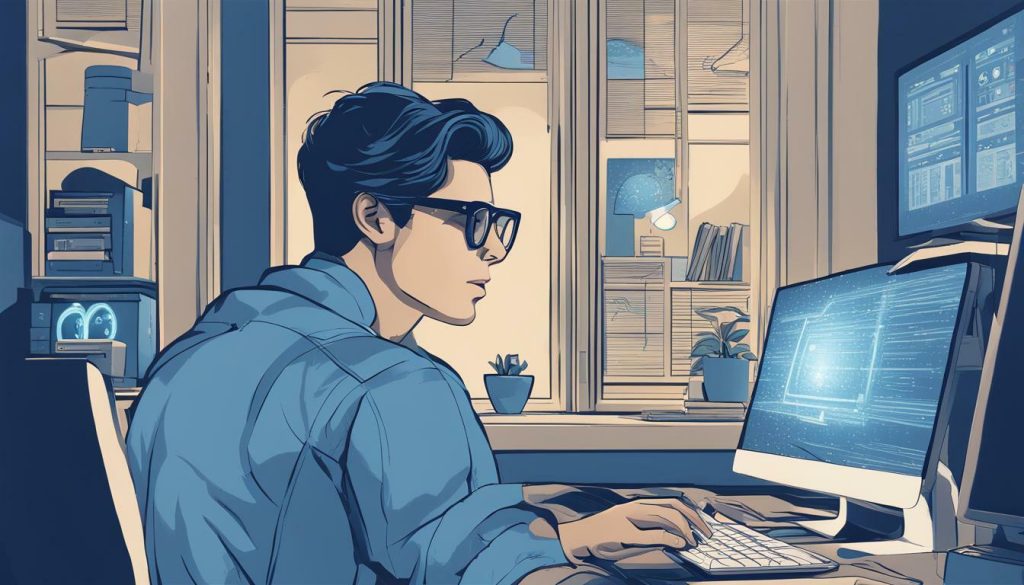
Using blue light blocking glasses is one effective strategy for reducing blue light exposure in the evening. These glasses have lenses that are designed to filter out blue light, allowing the body to naturally produce melatonin and regulate the sleep-wake cycle.
Managing blue light exposure can be a simple yet effective way to improve sleep quality and promote overall health and well-being.
Managing Blue Light Exposure
Reducing blue light exposure before bed is crucial for maintaining a healthy circadian rhythm and improving sleep quality. Here are some practical tips that you can implement:
- Avoid screens before bedtime: Limit screen time at least 1-2 hours before bedtime, as electronic devices emit a significant amount of blue light and can suppress melatonin production. Instead, try reading a physical book or practicing relaxation techniques.
- Use blue light filters: Many devices and apps offer blue light filters that reduce the amount of blue light emitted. You can also invest in blue light filter glasses that block blue light and improve melatonin secretion.
- Opt for warm-colored lights: Replace bright white or blue-tinted light bulbs in your bedroom with warm-colored bulbs that emit less blue light.
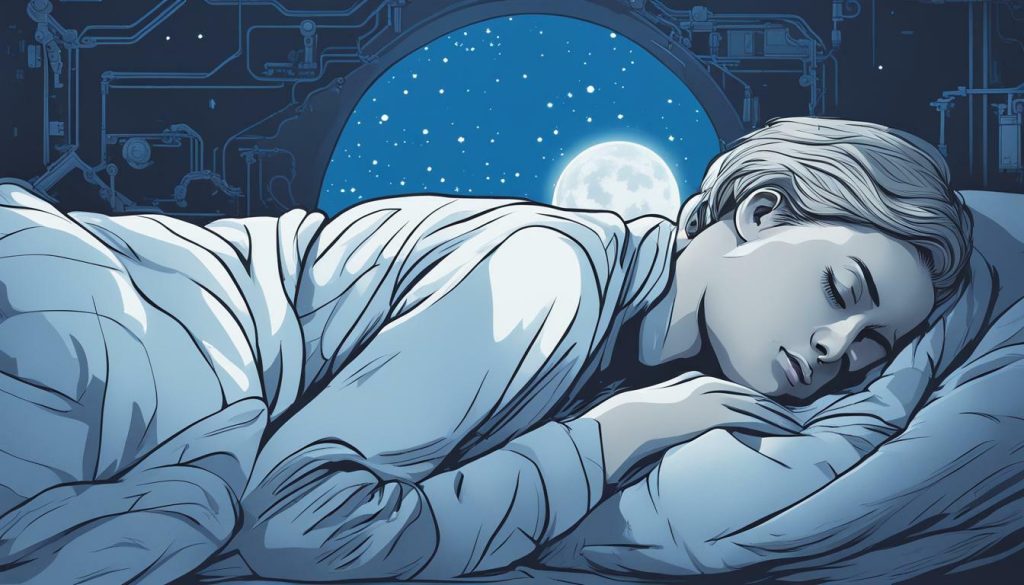
By reducing blue light exposure in the evening, you can improve your circadian rhythm and sleep quality. Don’t underestimate the impact of small changes – even minor adjustments can have a significant effect on your overall well-being.
Creating a Sleep-Friendly Environment
Minimizing blue light exposure in the bedroom is crucial to promoting a healthy circadian rhythm and better sleep quality. Here are some tips for creating a sleep-friendly environment:
- Use blackout curtains to block out external light sources.
- Keep electronic devices away from the bed or use blue light filters for screens.
- Dim the lights in the bedroom in the hours leading up to bedtime.
- Opt for warm-colored bulbs instead of bright white or blue lights.
Creating a peaceful and relaxing atmosphere in the bedroom can also help to promote better sleep quality. Consider adding soothing scents such as lavender or chamomile and investing in comfortable bedding and pillows.
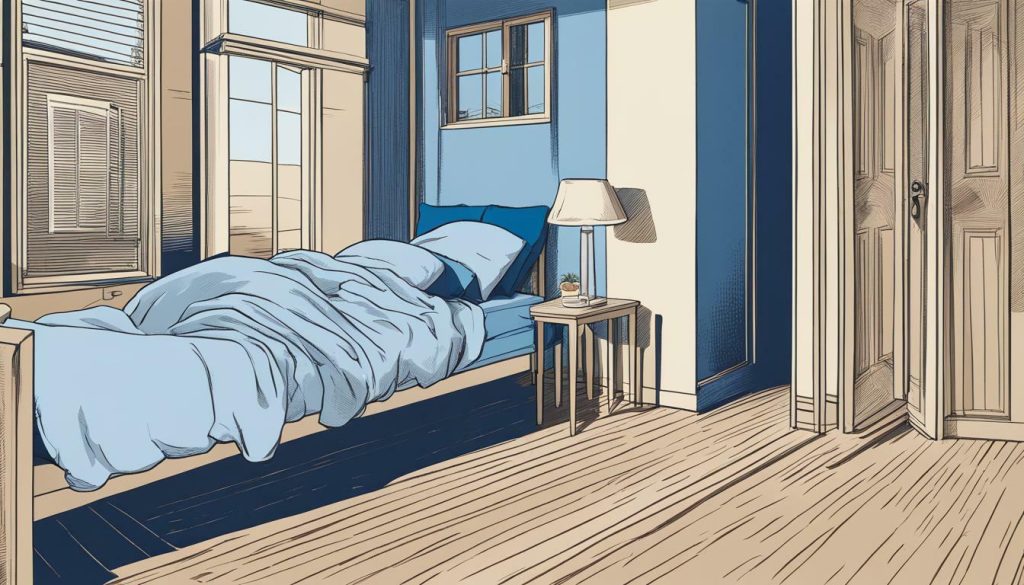
By following these tips, you can create a sleep-friendly environment in your bedroom and reduce the negative impact of blue light on your sleep patterns.
The Role of Blue Light in Shift Work and Jet Lag
Blue light exposure can have a significant impact on individuals who work night shifts or experience jet lag. These disruptions can cause sleep disorders and negatively affect overall health.
Shift work, especially night shifts, can cause circadian rhythm disruption, leading to sleep difficulties and insomnia. Blue light exposure during night shifts can worsen these effects by suppressing melatonin production, making it harder to fall asleep during the day.
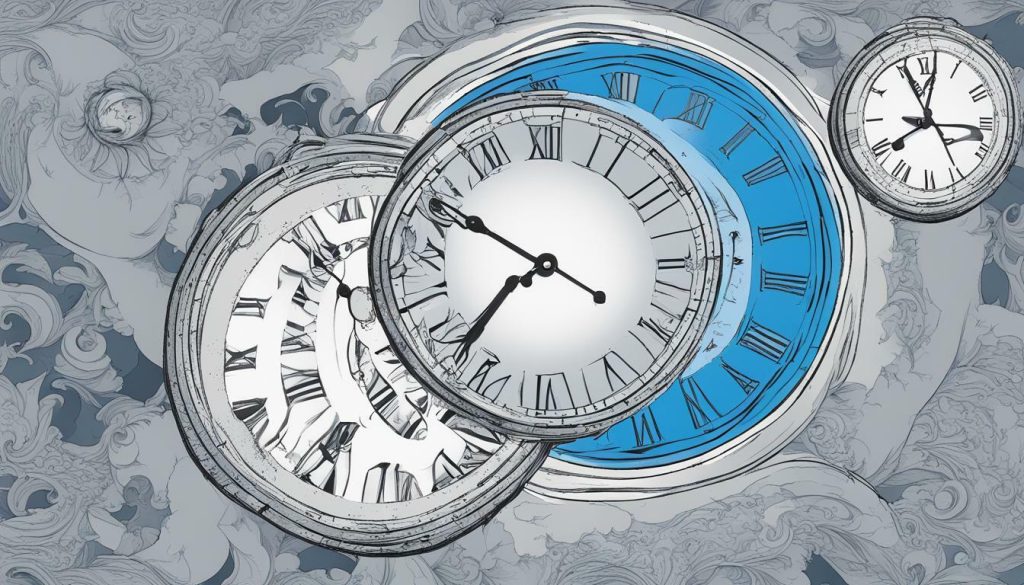
Jet lag, caused by traveling across multiple time zones, can also disrupt circadian rhythm. Exposure to blue light at the wrong time can make jet lag symptoms worse, leading to even more sleep difficulties and fatigue.
Managing blue light exposure can help regulate circadian rhythm in these situations. One strategy is to use blue light filters or glasses to reduce the amount of blue light exposure during night shifts or long flights. Another option is to seek out bright light exposure during the daytime to help reset the body’s internal clock.
It’s important to prioritize sleep and take steps to manage blue light exposure, especially for those who work night shifts or frequently travel across time zones. By doing so, individuals can improve sleep quality and overall health.
Conclusion
In conclusion, managing blue light exposure is crucial for regulating our internal clock and improving sleep quality. As we have seen, blue light has a significant impact on our circadian rhythm, suppressing melatonin production and disrupting sleep patterns. To mitigate these effects, it is important to limit blue light exposure in the evening, especially before bedtime.
Practical tips such as reducing screen time, using blue light filters or glasses, and creating a sleep-friendly environment can all help promote a healthy circadian rhythm and better sleep quality. Additionally, individuals who work night shifts or experience jet lag can benefit from managing blue light exposure to regulate their internal clock.
By taking steps to manage blue light exposure, we can improve our sleep quality and overall health. So, the next time you reach for your phone or turn on your computer in the evening, remember the impact it can have on your sleep and take the necessary steps to limit your exposure. Sweet dreams!
FAQ
Q: How does blue light affect circadian rhythm?
A: Blue light exposure, especially in the evening, can disrupt the natural circadian rhythm by suppressing the production of melatonin, a hormone that regulates sleep and wakefulness.
Q: What is circadian rhythm?
A: Circadian rhythm refers to the 24-hour internal clock that regulates various biological processes, including sleep-wake cycles. It is influenced by external factors such as light and darkness.
Q: How does blue light affect sleep patterns?
A: Blue light exposure can disrupt sleep patterns and contribute to sleep disorders. It can result in fragmented sleep, reduced deep sleep, and overall poor sleep quality.
Q: What are common sources of blue light?
A: Common sources of blue light include electronic devices such as smartphones, tablets, and computers, as well as artificial lighting such as LED and fluorescent bulbs.
Q: How can I manage blue light exposure?
A: To manage blue light exposure, it is recommended to limit screen time before bed, use blue light filters or glasses, and create a sleep-friendly environment with dim lights and warm-colored bulbs.
Q: What is the relationship between blue light and melatonin production?
A: Blue light exposure in the evening can suppress the release of melatonin, making it harder to fall asleep. Melatonin is a hormone that plays a crucial role in regulating sleep and wakefulness.
Q: How can blue light impact shift work and jet lag?
A: Blue light exposure can further disrupt the already disturbed circadian rhythm in individuals who work night shifts or experience jet lag. Managing blue light exposure can help regulate circadian rhythm in these situations.

